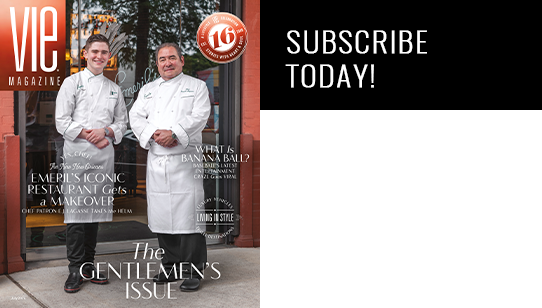
vie-magazine-lindsey-sterling-1
You Can Go Your Own Way
By Tori Phelps | Photography courtesy of Lindsey Stirling
Dancing, violin-playing, electronic folk–singing Lindsey Stirling has defied the odds—and Piers Morgan—to achieve chart-topping success, proving that you can sell out tours without selling your soul.
Pop. Rock. Country. Jazz. There are dozens of names for musical genres, all designed to pigeonhole musicians and their songs by sound. Once in a while, though, someone appears on the scene who defies labels, a rare voice that stands out in a crowd of “been there, heard that.”
Lindsey Stirling is one of those voices. Hers is an impossible-to-brand fusion of Celtic folk, classical, and dubstep, a subgenre of electronic dance music. It doesn’t seem like a combination that should work, but in Stirling’s talented hands, the effect is a mesmerizing, soul-stirring extravaganza of music and dance that has attracted millions of fans and sold out concerts all over the world.
And it all started with a violin.
I knew how much my
parents loved us and wanted
us to succeed. That made me
realize I needed to take
advantage of the gift they
were giving me
so willingly.
The instrument has been both companion and salvation since grade school, providing solace during painful periods and later helping to cement Stirling as an international music sensation. Her love affair with the violin started at home—in Gilbert, Arizona— where her father, a passionate devotee of orchestral music, played Borodin and Rimsky-Korsakov on the family’s old record player. Money was in short supply, but her dad managed to turn up free orchestra tickets for Stirling and her siblings. “It didn’t take me long to recognize who the stars of the orchestra were,” she says of the violinists.
At the age of six, Stirling began petitioning her parents for violin lessons, a seemingly impossible request for the cash-strapped family. But somehow they found the money, and their sacrifice motivated the young musician even more. “I knew how much my parents loved us and wanted us to succeed,” Stirling recalls. “That made me realize I needed to take advantage of the gift they were giving me so willingly.”
It was apparent almost immediately that her talent matched her interest level, and years of classical training shaped her natural gift into a skill set most musicians never achieve. While she now says it’s crucial for any violinist to have classical training, her high school self believed differently. “I started losing interest in violin because I felt classical music was too constrictive,” she says. “I wanted more freedom of expression—to write and play ‘fun’ music.”
If it gives me chills, energizes me, and makes me feel uplifted by
listening to it, I like it. If it doesn’t do that for me, I don’t.
For the first time since she could remember, Stirling was uninspired by the violin. Instead, she developed an interest in fiddling and joined a rock band, where her passion for music roared back to life. It was the first “crossover” experience for Stirling, who eventually would make genre crossovers her signature.
Looking back, it seems one style was never meant to pin her down. Her favorite artists growing up ranged from the female string quartet Bond to indie rockers Weezer and King of Pop Michael Jackson. Other than country-western music, which she admits isn’t a favorite despite her stint as a fiddler in a country band, she loves it all. “There isn’t one style I prefer over another,” she insists. “If it gives me chills, energizes me, and makes me feel uplifted by listening to it, I like it. If it doesn’t do that for me, I don’t.”
Among the most recognizable elements in Stirling’s music is Celtic folk, a sound to which she’s been drawn since Riverdance swept onto the world stage during her youth. “I’ve always loved the energy and, of course, the dancing in Celtic folk music,” she says. “It’s one of those unique mediums somewhere between violin classical and pop; I guess that’s why I gravitated to it from the beginning.”
The realization early on that she wouldn’t be happy following a traditional path created a dilemma for Stirling. She was a classically trained violinist with no intention of playing only classical music. She wanted to explore everything on the musical spectrum that inspired her in an industry that preferred simple labels. She faced nothing less than a question of her musical identity.
The answer was both easy and insanely difficult: chart her own course. “I searched for opportunities to create and perform music I enjoyed playing,” she explains. “I made my own music videos with friends, I wrote simple pop songs, I taught myself how to dance, I dreamed, and I set goals.”
It was the dreams and goals, she says, that kept her going when she wanted to give up—like when she was voted off America’s Got Talent. She first gained widespread exposure during the reality show’s 2010 season, making it to the quarterfinals. Despite her apparent viewer appeal, then-judge Piers Morgan told Stirling the world had no place for a dancing dubstep violinist.
He was wrong.
Though she felt “terrible” after her elimination from the show, she used the experience to strengthen her resolve and ultimately soar to new heights. “I learned that it’s moments like these that really define us,” she says. “Do we cave, or do we do the impossible? I decided that if I was supposed to become a professional musician, I was going to do everything in my power to make it happen. And if it was meant to be, I knew God would open the door.”
The door did open, but it took quite a bit of shoving. While she says a competition like America’s Got Talent can be a fantastic springboard for an entertainer’s career, hers fell flat after the show. No one seemed interested in promoting her, so she promoted herself, funding her first three singles (“Spontaneous Me,” “Song of the Caged Bird,” and “Transcendence”) on her own. But sales were mediocre at best, as were the gigs she booked. Everything seemed to be a dead end—until she met filmmaker Devin Graham. “He offered to collaborate to help me make my first professional video for YouTube,” Stirling says, “and my career finally started taking off.”
In 2012 she released a self-titled album that included “Crystallize,” a hit single that almost didn’t make it to the public. Fearing backlash from the dubstep community over the song’s very different sound, Stirling once again had to fight through doubt and take a leap of faith. “When the song took off like it did, I was totally dumbfounded,” she admits. “It was the most incredible feeling to finally see my dream becoming a reality.”
Her latest album, Shatter Me, features collaborations with Lzzy Hale of the Grammy-winning band Halestorm and The Voice runner-up Dia Frampton, formerly of Meg & Dia. Stirling wrote all twelve songs on the album, drawing inspiration from her successes and failures, as well as the people and relationships that have made an impact on her life.
The album, which she says she “poured her heart into,” is a very personal collage. Which also made it a very big risk. Fortunately, the risk paid off. Shatter Me debuted at number two on the Billboard 200 album chart when it was released earlier this year. Oh, and did she mention this was all accomplished without the help of a major label?

I collaborated with other
successful artists, and when I
released ‘Crystallize’ and it went
viral, everything changed.
The music industry has been forever changed because of social media sites like YouTube that allow performers to attract fans—or not—based on their talent. And that’s a good thing, according to Stirling. “It used to be that you absolutely needed a major label to pick you up, promote you, and get your music on the radio to become successful,” she explains. “I couldn’t get any major label interested in me, let alone willing to sign a contract with me, but I was able to promote myself through YouTube. I collaborated with other successful artists, and when I released ‘Crystallize’ and it went viral, everything changed. I found a manager, I had the fan base to go on my first tour, and everything snowballed from there.”
Even traditional radio play isn’t crucial to chart-topping success, thanks to Pandora and other Internet radio providers. Perhaps that’s why Stirling still isn’t in any rush to sign with the labels that wouldn’t take a chance on her until she’d already started selling out concert venues. She’s adopted a “never say never” position on the question of labels, but today’s position is no. “I haven’t needed one so far,” she points out.
Instead, she’ll continue to make music and enjoy her success the same way she does everything else: on her own terms.
— V —
Share This Story!
KEEP UP WITH THE LATEST STORIES FROM VIE







































































































































